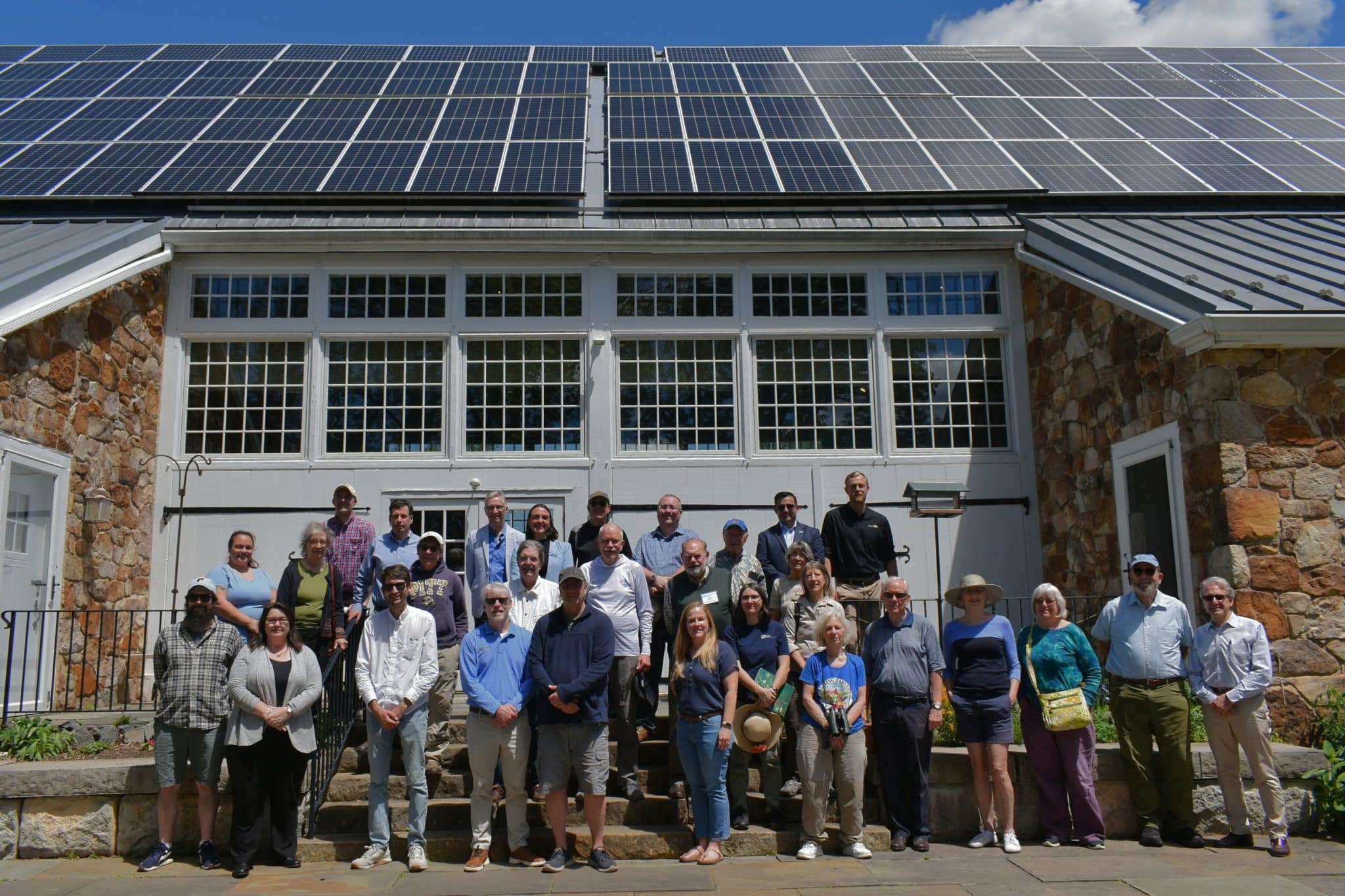On a sunny spring day outside of Honey Hollow Education Center in New Hope, Bucks County Audubon Society held an informational meeting about their solar panel array and the shared ways that the state government and Solebury Township are mitigating the local effects of climate change.
The speakers at Wednesday’s event included Leo McDonald, a science teacher at the New Hope Solebury High School, Aaron Nichols from Exact Solar, Michael Celec, executive director of Bucks County Audubon Society, Flora Cardoni, deputy director at PennEnvironment, and John Francis, Solebury Township Supervisor. They addressed topics such as financial incentives of solar panelling and clean energy legislation.
Much of the Audubon Society’s work is environmental education, and the solar panel installation provides a learning opportunity about clean energy for community members and visitors. But it also helps pay the bills.
In September 2020, with the help of Exact Solar, the Audubon Society installed a solar energy system at their Honey Hollow Environmental Education Center in Solebury. The funding came from their Capture the Sun campaign, which reeled in hundreds of donations from community members. The solar panel array has produced 100 percent of the Audubon Society’s electricity needs and of the family who occupies a house on the property.
Despite the fact that Pennsylvania ranks 49th in the country for renewable energy growth, it still generates 371% more solar power than it did in 2014. McDonald, who was the leader of the committee which worked to hire Exact Solar, said even though most of the state’s electricity is from natural gas, nuclear energy, and coal, renewables are increasing.
The solar array cost $55,000 to install, and since then, it has generated 178 megawatt hours of electricity. This amount of electricity represents a $33,286 value. With the panels having a 30-year guaranteed lifespan, the profit for the Audubon Society, according to McDonald, will be substantial.
“I calculate we’re going to make $232,000 minus our $55,000 initial investment, which will be a $177,000 profit for the center on that investment back in 2020,” McDonald said.
The solar panels were installed prior to Biden’s Inflation Reduction Act, which included elective pay, allowing non-profits to claim clean energy tax credits as if they were for-profit entities. At the time of installation, the founders of Exact Solar retained ownership for five years with a lease. When the lease expires in December 2025, it will be donated back to the society and the community at large.
“Can anyone here think of a coal-fired power plant that was donated back to the community after it was built? Can anyone here think of a fracking rig that was built and then turned over to a township after five years so that they could retain the benefits of the energy?” Exact Solar’s Nichols asked. “I’ll bet you’re hard-pressed to think of them, but stories like this are common in the solar industry.”
Financial incentives are a popular reason to invest in solar power for many people, including the Audubon Society, as Celec detailed in an interview with the Beacon.
“We don’t really get an electric bill. We get a check from the electric company,” Celec said. “And so it’s good for our operations, but it’s also good in terms of generating clean energy and putting energy back on the grid.”
The Residential Clean Energy Credit, implemented in 2022 and continuing through 2032, provides a 30 percent tax credit for people who have made energy-saving improvements to their homes. PECO also offers financial incentives for businesses and residents who choose to install solar panels.
“I think we’d love to see utilities give more incentives and better rates back to solar installers,” PennEnvironment’s Cardoni said. “And certainly, unfortunately, utilities often get involved in trying to stop state policy from moving forward.”
State senator Steve Santarsiero and state representative Danielle Otten are sponsors of The Pennsylvania Reliable Sustainability Standard (PRESS), which is part of Governor Shapiro’s Lightning Plan and builds on the 2004 Alternative Energy Portfolio Standards. PRESS promotes battery storage, nuclear power, fusion technologies, and incentivizes lower emissions for gas-fired power plants and innovative technology like linear generators.
According to Cardoni, the bill passed the state house last year, but stalled in the senate despite having bipartisan support. . A new version was reintroduced in this year’s session that includes recommendations from a large coalition of groups to make it easier on ratepayers to opt into solar arrays. And while it is expected to pass through the house again, it will likely not make it out of the Republican-controlled senate.
Solebury Township has also been focusing on addressing the local impacts of climate change, including reducing the deer population, improving the insulation energy efficiency of township buildings, adding electric and hybrid vehicles to the township police department, passing an alternative energy ordinance which promotes residential installation of alternative energy projects, and increasing the acreage of parks and preserved land, which is currently over 40 percent of the township.
Solebury Township Supervisor Francis spoke about the township’s Energy Transition Plan, which was adopted in 2022 and set a goal to reach 100 percent clean renewable energy by 2035 for electricity and by 2050 for heat and transportation. The full roadmap can be found here.
“All in all, we think we’re ahead of the curve, well on our way to meeting our energy transition goals,” Francis said. “And projects like this at Audubon are a positive and tangible example of how to do it and how to have a significant and positive effect on our local environment.”







